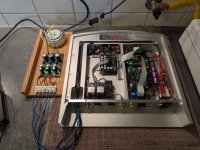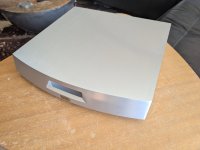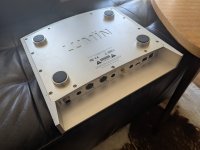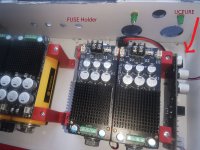Why not post it here? All of us are curious.
I don't think this is the right place to go into great detail. It would get way too off-topic. However, I would be happy to tack it onto the end of my open source Clock Board thread: https://www.diyaudio.com/community/threads/general-purpose-dac-clock-board.413001/post-7974960
Last edited:
I concur 100%. I don't understand most of what I am doing, but I can read instructions. LOL My younger brother has a very high end system, and while he doesn't have a streamer I'm pretty confident my stuff rivals his, and he has a Sim Audio cd player/DAC, with Mark Levinson mono amps, and Dunlavy speakers. I built Joe Rasmussen's Elsinores, and they are pretty darn close to his Dunlavy's although I bet they would sound even better than his Dunlavy's if we did a straight swap, because everything else in his system is high end. He has a better pre-amp etc.I've discovered Ian's solutions, and sincerely I'm really happy of what I have built so far : it was easy and not so expensive compared to commercial streamer/dacs , and it really outperforms most of them. Thanks to Ian I have started a DAC in DIY mode... I would probably never have started without his products.
@Markw4 Most of what you're posting is going right over my head, but I'm loving your input anyway, and I don't think you've posted anything that could be construed to be stepping on Ian's toes. I think most of us in DIY who are like me, and all like sponges soaking up as much as we can. haha. Even if we don't understand everything.
Markw,The basis of your intentions is good, that's the most important thing,
moreover, when we need a helping hand you are always there, thank you.
moreover, when we need a helping hand you are always there, thank you.
am working on a streamer/dac in an empty Lumin S1 case, almost 8 kilograms of pure aluminum.
I don't have much space and it is only 4 cm high.
ES9038Q2M Dual Mono II, FifoPiMa, PurePi-ll 3.3v-5v, Transformer I/V.
just need a monitorPi pro screen in between....next week see if there is any sound coming out of it.
Finally, the power supply comes in an external cabinet with a nice cable with screw coupling.
I don't have much space and it is only 4 cm high.
ES9038Q2M Dual Mono II, FifoPiMa, PurePi-ll 3.3v-5v, Transformer I/V.
just need a monitorPi pro screen in between....next week see if there is any sound coming out of it.
Finally, the power supply comes in an external cabinet with a nice cable with screw coupling.
Attachments
Last edited:
Did it work for you? I just noticed that DSD plays sound on single channel only. Now I don't know is reason patched driver or my dac configuration code... PCM works fine...I'd be interested in the patch instructions.
I wish you lived close to me, you'd never get rid of me! LOL. Nice work...AGAIN!am working on a streamer/dac in an empty Lumin S1 case, almost 8 kilograms of pure aluminum.
Ian helped me fix my UCPure issue. The guy I bought it from sent me plastic nuts to use on the super caps, and turns out that was the problem. It was trying to go into "protection mode" to recharge the supercaps. I guess it was not making a good enough connection. In any case I went and bought steal bolts, and it's fixed. Here';s what it was doing. It was also "loosing" it's charge much faster before. It took a lot longer before it tried to go into recharge mode, and it switched back to "pure mode" just like Ian said, in only 2 or 3 minutes.
Here's the video I sent Ian.
Here's the video I sent Ian.
LOL.I wish you lived close to me, you'd never get rid of me! LOL. Nice work...AGAIN!
maybe emigrating to the Netherlands is an option 😁
Hi All, On the UCPure MkIII . there is a Fuse , I want to move the actual fuse to the rear panel , as replacing the fuse will be difficult as the board will be in an awkward position (did not think about this when designing the case (so many , so many mistakes🙁 )). Is this possible without causing any issues , The fuse with be about 4 inches away.
Attachments
Anyone managed to play DSD64/128 (including DoP) on both channels using RPI + FifoPiMa combination? If yes I would like to know your setup: linux driver, wiring to dac, player software...
Similar thing happened to my PurePi that uses lithium batteries underneath. The PurePi was clicked exactly like yours. I turns out that the batteries came loose and had to be pushed back up to make better contact. I was lifting and moving the dac around a lot.It was trying to go into "protection mode" to recharge the supercaps. I guess it was not making a good enough connection. I
So I got my Receiver Pi DDC II today. Unfortunately I haven't had a chance to really use it yet, but I did get it working and tested. I want to use it with my Oppo 103 because I have a lot of concert DVDs and Blurays. I have a question for anyone my technical than I am. It's working with a RCA digital cable, but I can't get it to work with the HDMI. I checked the settings and made sure it's set to PCM for the HDMI out on the Oppo, but it doesn't "lock." It plays fine when I switch to RCA. Any ideas?
hi, I'm new here and starting a new build for a streamer+dac, based on Ian's parts, but I'm not sure which I/V stage to use.
regardless of price and complexity, how would you rate these options terms of sound quality:
1. OPA861
2. stock Transformer I/V with SQAUDIO DS2206
3. Transformer I/V kit with Lundahl 1544A
4. Transformer I/V kit with another transformer
5. Other?
regardless of price and complexity, how would you rate these options terms of sound quality:
1. OPA861
2. stock Transformer I/V with SQAUDIO DS2206
3. Transformer I/V kit with Lundahl 1544A
4. Transformer I/V kit with another transformer
5. Other?
Hi,hi, I'm new here and starting a new build for a streamer+dac, based on Ian's parts, but I'm not sure which I/V stage to use.
regardless of price and complexity, how would you rate these options terms of sound quality:
1. OPA861
2. stock Transformer I/V with SQAUDIO DS2206
3. Transformer I/V kit with Lundahl 1544A
4. Transformer I/V kit with another transformer
5. Other?
Are you using balanced ou single ended outputs ?
In my case, I’m using SE. I have started with a OPA861 but I have discovered a bit too late that the SE outputs are not high end.
So I switched to I/V Lundahl 1544A and this is way better.
I will soon receive Ivan’s I/V board, so I will better able to compare. I am expecting a real gap.
If you are using balanced outputs, I think that you should try OPA861.
did you try converting the balanced outputs to SE?I have started with a OPA861 but I have discovered a bit too late that the SE outputs are not high end.
I can use both, but planning on using balanced.If you are using balanced outputs, I think that you should try OPA861.
Yes. Not very good.did you try converting the balanced outputs to SE?
@danilog @MathieuDoe
In a dual mono DAC configuration utilizing two ESS chips, the architecture is optimized for balanced signal paths. When operating in single-ended mode, only one half of the DAC’s differential output is used, effectively bypassing the benefits of the dual-chip topology. This results in a suboptimal implementation where the full dynamic range and distortion performance of both DAC channels are not realized.
Introducing output transformers into the signal path places the system’s fidelity at the mercy of the transformer’s bandwidth and core material quality. Even high-end transformers typically exhibit a slight roll-off and phase shift below 100Hz, contributing to a minor but measurable reduction in bass extension and control. While negligible in systems with inherently strong low-frequency response, this may still affect overall tonal balance.
A more critical compromise with transformers in my experience, was the degradation of spatial characteristics—specifically, imaging precision and perceived depth.
Compared to a good active buffer stage like the OPA861. The transformer-coupled output lacked the same holographic rendering and separation
If you’re committed to single-ended—and I personally love and believe in single-ended for short runs (though that’s a topic of debate for another day)—I’d recommend going with a true single-ended DAC instead and No transformers, while still using the amazing streamers reclocker and power supplies that Ian designed.
Please note that this is my personal observation in my systems and others may vary.
Hope that helps
In a dual mono DAC configuration utilizing two ESS chips, the architecture is optimized for balanced signal paths. When operating in single-ended mode, only one half of the DAC’s differential output is used, effectively bypassing the benefits of the dual-chip topology. This results in a suboptimal implementation where the full dynamic range and distortion performance of both DAC channels are not realized.
Introducing output transformers into the signal path places the system’s fidelity at the mercy of the transformer’s bandwidth and core material quality. Even high-end transformers typically exhibit a slight roll-off and phase shift below 100Hz, contributing to a minor but measurable reduction in bass extension and control. While negligible in systems with inherently strong low-frequency response, this may still affect overall tonal balance.
A more critical compromise with transformers in my experience, was the degradation of spatial characteristics—specifically, imaging precision and perceived depth.
Compared to a good active buffer stage like the OPA861. The transformer-coupled output lacked the same holographic rendering and separation
If you’re committed to single-ended—and I personally love and believe in single-ended for short runs (though that’s a topic of debate for another day)—I’d recommend going with a true single-ended DAC instead and No transformers, while still using the amazing streamers reclocker and power supplies that Ian designed.
Please note that this is my personal observation in my systems and others may vary.
Hope that helps
A more critical compromise with transformers in my experience, was the degradation of spatial characteristics—specifically, imaging precision and perceived depth.
Compared to a good active buffer stage like the OPA861. The transformer-coupled output lacked the same holographic rendering and separation
If you’re committed to single-ended—and I personally love and believe in single-ended for short runs (though that’s a topic of debate for another day)—I’d recommend going with a true single-ended DAC instead and No transformers, while still using the amazing streamers reclocker and power supplies that Ian designed.
Thank you Gabster for sharing your thoughts. This is very interesting.
So, what DAC and I/V conversion would your recommend to benefit of a high true single ended architecture on top of Ian's platform ?
I'm really attracted by holographic rendering, separation and depth...
- Home
- Source & Line
- Digital Line Level
- Asynchronous I2S FIFO project, an ultimate weapon to fight the jitter



